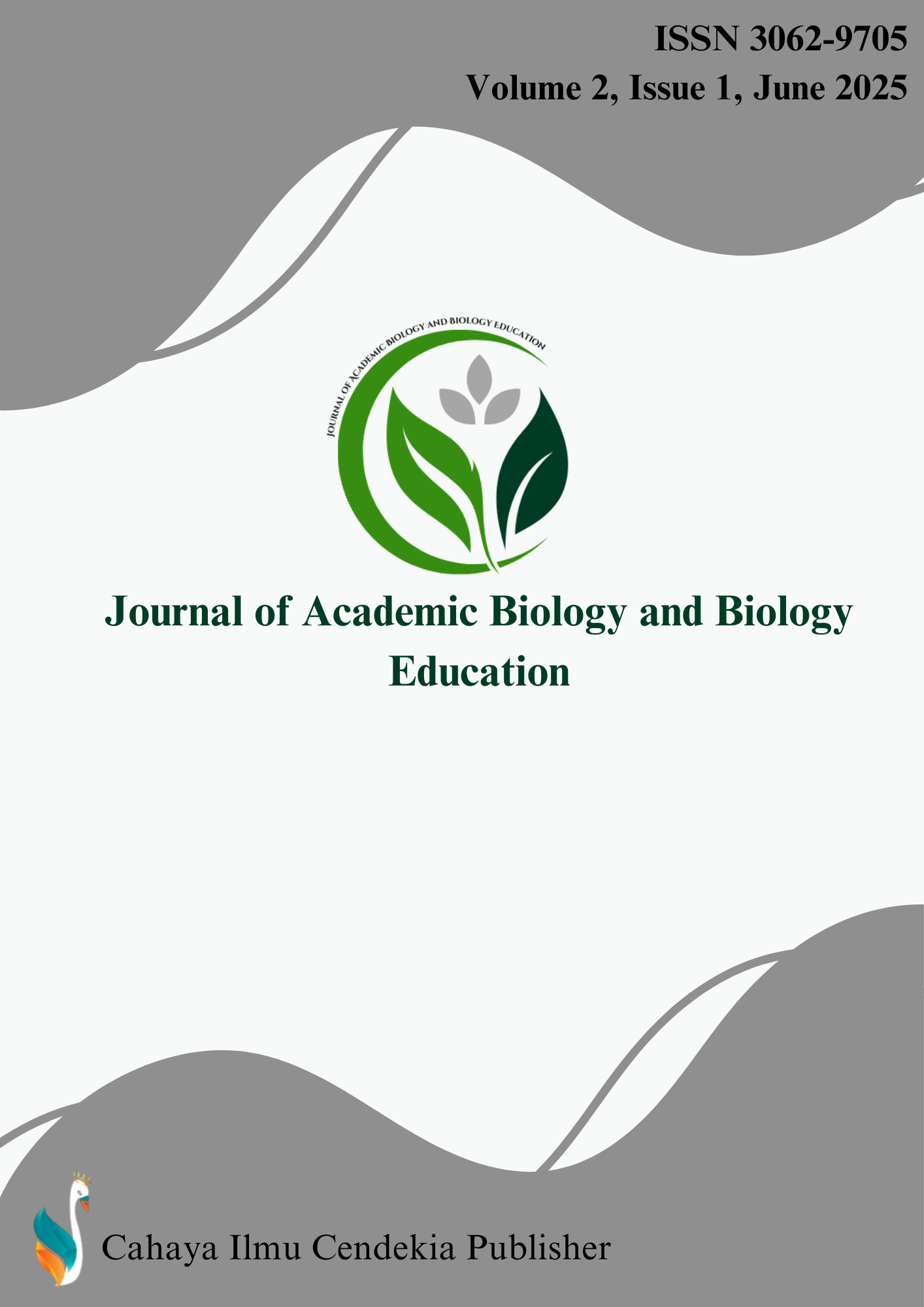The Activity of Papaya Seeds (Carica papaya L.) Varieties of “Bangkok” and “California” in Inhibiting the Growth of Pathogenic Bacteria
Abstract
Purpose of the study: The purpose of this study is to evaluate the antibacterial activity of ethanol extracts from Bangkok and California papaya (Carica papaya) seeds against E. coli, Salmonella sp., and S. aureus, and to identify the chemical compounds responsible for their antibacterial properties using GC–MS analysis.
Methodology: This study applied a Completely Randomized Design (CRD) using ethanol extracts of Carica papaya seeds. Equipment included GC–MS, rotary evaporator, autoclave, laminar flow, vortex mixer, hot plate, incubator, and micrometer. Media and reagents were NA, NB, MHA, ethanol, DMSO, and Amoxicillin. Tested bacteria were E. coli, Salmonella sp., and S. aureus. Data were analyzed with ANOVA and DMRT using SPSS.
Main Findings: Ethanol extracts of Carica papaya seeds (‘Bangkok’ and ‘California’) significantly inhibited E. coli, Salmonella sp., and S. aureus growth. The highest inhibition zones occurred at 20% concentration, with ‘California’ showing stronger activity against Salmonella sp. and ‘Bangkok’ against S. aureus. MIC was 20% for Gram-negative bacteria. GC–MS identified 20 compounds in ‘Bangkok’ and 24 in ‘California’, dominated by hexadecanoic acid and various alkaloids, flavonoids, terpenoids, and fatty acids.
Novelty/Originality of this study: This study provides new insights by comparing the antibacterial activity and chemical composition of ethanol extracts from Carica papaya seeds of ‘Bangkok’ and ‘California’ varieties. It identifies specific bioactive compounds through GC–MS and reveals variety-dependent antibacterial effects, advancing knowledge of papaya seeds as natural antibacterial agents and supporting their potential development as alternative antimicrobial resources.
References
C. G. Nkwonta, C. I. Auma, and Y. Gong, “Underutilised food crops for improving food security and nutrition health in Nigeria and Uganda—a review,” Front. Sustain. Food Syst., vol. 7, no. July, 2023, doi: 10.3389/fsufs.2023.1126020.
M. Jiao et al., “Biological functions and utilization of different part of the papaya: a review,” Food Rev. Int., vol. 39, no. 9, pp. 6781–6804, Oct. 2023, doi: 10.1080/87559129.2022.2124415.
A. Garg, P. Vishvakarma, and S. Mandal, “Exploring carica papaya seeds extract as a herbal jelly for helminthiasis treatment: a comprehensive analysis,” World J Pharm Pharm Sci, vol. 12, no. 5, pp. 763–775, 2023, doi: 10.20959/wjpps20235-24744.
X. Zhang, J. Liang, X. Lin, J. Chen, and X. Luo, “A comprehensive review on the composition, processing methods, and sustainable utilization of tropical fruit seeds in food industry,” Food Front., vol. 6, no. 2, pp. 644–669, 2025, doi: 10.1002/fft2.493.
Y. R. Kong et al., “Beneficial role of carica papaya extracts and phytochemicals on oxidative stress and related diseases: A mini review,” Biology (Basel)., vol. 10, no. 4, pp. 1–20, 2021, doi: 10.3390/biology10040287.
F. Usman, M. Ibrahim, D. S. Talatu, A. A. Atiben, and I. V. Agyu, “Preliminary study of the phytochemical constituents and antimicrobial activity of the ethanolic extract of papaya ( Carica Papaya ) seed,” ChemClass J., vol. 9, no. 2, pp. 563–570, 2025, doi: 10.33003/chemclas-2025-0902/179.
J. Soni, S. Sinha, and R. Pandey, “Understanding bacterial pathogenicity: a closer look at the journey of harmful microbes,” Front. Microbiol., vol. 15, no. Figure 1, pp. 963–986, Feb. 2024, doi: 10.3389/fmicb.2024.1370818.
V. T. Anju, S. Busi, M. S. Mohan, and M. Dyavaiah, “Chapter 2 - Bacterial infections: Types and pathophysiology,” in Developments in Microbiology, A. K. Dhara, A. K. Nayak, and D. B. T.-A.-T. S. and L. Chattopadhyay, Eds., Academic Press, 2023, pp. 21–38. doi: 10.1016/B978-0-323-95388-7.00004-8.
G. Mancuso, A. Midiri, E. Gerace, and C. Biondo, “Bacterial antibiotic resistance: the most critical pathogens,” Pathogens, vol. 10, no. 10, pp. 1–14, 2021, doi: 10.3390/pathogens10101310.
Z. Jian et al., “Antibiotic resistance genes in bacteria: occurrence, spread, and control,” J. Basic Microbiol., vol. 61, no. 12, pp. 1049–1070, 2021, doi: 10.1002/jobm.202100201.
D. Dahiya and P. S. Nigam, “Antibiotic-therapy-induced gut dysbiosis affecting gut microbiota—brain axis and cognition: restoration by intake of probiotics and synbiotics,” Int. J. Mol. Sci., vol. 24, no. 4, p. 3074, Feb. 2023, doi: 10.3390/ijms24043074.
R. Urban-Chmiel et al., “Antibiotic resistance in bacteria—a review,” Antibiotics, vol. 11, no. 8, p. 1079, Aug. 2022, doi: 10.3390/antibiotics11081079.
P. P. Kalelkar, M. Riddick, and A. J. García, “Biomaterial-based antimicrobial therapies for the treatment of bacterial infections,” Nat. Rev. Mater., vol. 7, no. 1, pp. 39–54, 2022, doi: 10.1038/s41578-021-00362-4.
O. R. Alara, N. H. Abdurahman, and J. A. Alara, “Carica papaya: comprehensive overview of the nutritional values, phytochemicals and pharmacological activities,” Adv. Tradit. Med., vol. 22, no. 1, pp. 17–47, 2022, doi: 10.1007/s13596-020-00481-3.
A. Irmawati et al., “The difference of antibacterial properties extract seeds papaya and papaya leaves (Carica papaya L) against streptococcus mutans,” Res. J. Pharm. Technol., vol. 17, no. 9, pp. 4353–4362, 2024, doi: 10.52711/0974-360X.2024.00673.
H. K. Santra, S. Maity, and D. Banerjee, “Production of bioactive compounds with broad spectrum bactericidal action, bio-film inhibition and antilarval potential by the secondary metabolites of the endophytic fungus Cochliobolus sp. APS1 isolated from the Indian medicinal herb Andrographis panicu,” Molecules, vol. 27, no. 5, p. 1459, Feb. 2022, doi: 10.3390/molecules27051459.
N. A. Matrose, K. Obikeze, Z. A. Belay, and O. J. Caleb, “Impact of spatial variation and extraction solvents on bioactive compounds, secondary metabolites and antifungal efficacy of South African Impepho [Helichrysum odoratissimum (L.) Sweet],” Food Biosci., vol. 42, p. 101139, 2021, doi: 10.1016/j.fbio.2021.101139.
X. Feng and C. O. Iheanacho, “Potential clinical relevance of Buchholzia coriacea: in vitro antimicrobial characteristics of the methanol leaf extract,” BMC Complement. Med. Ther., vol. 25, no. 1, 2025, doi: 10.1186/s12906-025-05057-9.
S. Bibi, M. H. Abu-Dieyeh, and M. A. Al-Ghouti, “Biosynthesis of silver nanoparticles from macroalgae Hormophysa triquetra and investigation of its antibacterial activity and mechanism against pathogenic bacteria,” Sci. Rep., vol. 15, no. 1, pp. 1–20, 2025, doi: 10.1038/s41598-024-84760-y.
E. Dagne, B. Dobo, and Z. Bedewi, “Antibacterial activity of papaya (Carica papaya) leaf and seed extracts against some selected gram-positive and gram-negative bacteria,” Pharmacogn. J., vol. 13, no. 6, pp. 1727–1733, 2021, doi: 10.5530/pj.2021.13.223.
M. S. A. Sani, J. Bakar, A. Azid, and M. J. Iqbal, “Chemometrics-based evaluation on the effect of sonication, contact time and solid-to-solvent ratio on total phenolics and flavonoids, free fatty acids and antibacterial potency of Carica papaya seed against S. enteritidis, B. cereus, V. vulnificus and P.,” Food Chem. Adv., vol. 1, p. 100033, 2022, doi: 10.1016/j.focha.2022.100033.
S. O. Tumembow, V. N. S. Wowor, and E. Tambunan, “Pengaruh konsumsi buah pepaya california dan pepaya hawai terhadap penurunan indeks debris anak [The effect of consuming California papaya and Hawaiian papaya on reducing the debris index in children],” e-GIGI, vol. 6, no. 2, Jul. 2018, doi: 10.35790/eg.6.2.2018.20458.
U. S. Geletu, M. A. Usmael, and A. M. Ibrahim, “Isolation, identification, and Susceptibility Profile of E. coli, Salmonella, and S. aureus in Dairy Farm and Their Public Health Implication in Central Ethiopia,” Vet. Med. Int., vol. 2022, 2022, doi: 10.1155/2022/1887977.
S. Cho, C. R. Jackson, and J. G. Frye, “The prevalence and antimicrobial resistance phenotypes of Salmonella, Escherichia coli and Enterococcus sp. in surface water,” Lett. Appl. Microbiol., vol. 71, no. 1, pp. 3–25, 2020, doi: 10.1111/lam.13301.
R. Agada, W. A. Usman, and S. Shehu, “GC–MS and FTIR analysis of crude extracts of carica papaya seed,” Aust. J. Basic Appl. Sci., vol. 13, no. 11, pp. 51–59, 2019, doi: 10.22587/ajbas.2019.13.11.7.
T. Nakamura, Y. Murata, and Y. Nakamura, “Characterization of benzyl isothiocyanate extracted from mashed green papaya by distillation,” Food Chem., vol. 299, p. 125118, 2019, doi: 10.1016/j.foodchem.2019.125118.
H. H. Soib, H. F. Ismail, F. Husin, M. H. Abu Bakar, H. Yaakob, and M. R. Sarmidi, “Bioassay-guided different extraction techniques of Carica papaya (Linn.) leaves on in vitro wound-healing activities,” Molecules, vol. 25, no. 3, Jan. 2020, doi: 10.3390/molecules25030517.
S. Goriainov et al., “Study of the chemical composition of Carica papaya L. seed oils of various geographic origins,” Horticulturae, vol. 9, no. 11, p. 1227, Nov. 2023, doi: 10.3390/horticulturae9111227.
G. M. J. Torar, W. A. Lolo, and G. Citraningtyas, “Uji aktivitas antibakteri ekstrak etanol biji pepaya (Carica papaya L.) terhadap bakteri Pseudomonas aeruginosa Dan Staphylococcus aureus,” J. Ilm. Farm., vol. 6, no. 2, pp. 2302–2493, 2017, [Online]. Available: https://ejournal.unsrat.ac.id/index.php/pharmacon/article/download/15833/15342
F. S. Alhodieb, M. Farid, M. Sabir, S. Nisa, S. Sarwar, and S. Abbas, “Exploring the bioactive compounds of Carica papaya leaves: phytol’s role in combatting antibiotic-resistant bacteria,” Front. Cell. Infect. Microbiol., vol. 15, no. July, pp. 1–15, 2025, doi: 10.3389/fcimb.2025.1564787.
I. Fitri and D. I. Widiyawati, “Efektivitas antibakteri ekstrak herba meniran (Phylanthus niruni) terhadap pertumbuhan bakteri Salmonella sp. dan Propionibacterium acnes [Antibacterial effectiveness of meniran (Phylanthus niruni) herbal extract against the growth of Salmonella sp. and P,” JST (Jurnal Sains dan Teknol., vol. 6, no. 2, pp. 300–310, 2017, doi: 10.23887/jstundiksha.v6i2.11815.
R. Gupta, M. Lavollay, J. Mainardi, M. Arthur, R. Bishai, and G. Lamichhane, “The Mycobacterium tuberculosis gene, IdtMt2, encodes a non-classical transpeptidease required for virulence and resistance to amoxicillin,” Nat. Med., vol. 16, no. 4, pp. 466–469, 2010, doi: 10.1038/nm.2120.The.
I. Nikolaidis, S. Favini‐Stabile, and A. Dessen, “Resistance to antibiotics targeted to the bacterial cell wall,” Protein Sci., vol. 23, no. 3, pp. 243–259, Mar. 2014, doi: 10.1002/pro.2414.
R. Ilham, A. Lelo, U. Harahap, T. Widyawati, and L. Siahaan, “The effectivity of ethanolic extract from papaya leaves (Carica papaya L.) as an alternative larvacide to Aedes spp,” Open Access Maced. J. Med. Sci., vol. 7, no. 20, pp. 3395–3399, 2019, doi: 10.3889/oamjms.2019.432.
M. H. Shahrajabian, “Potential health benefits of papaya ( Carica papaya ) in modern and traditional medicine with considering its phytochemistry and nutritional components,” Curr. Agron., vol. 54, no. 2, pp. 83–105, 2025, doi: 10.2478/cag-2025-0008.
F. Eshboev et al., “Antimicrobial action mechanisms of natural compounds isolated from endophytic microorganisms,” Antibiotics, vol. 13, no. 3, p. 271, Mar. 2024, doi: 10.3390/antibiotics13030271.
S. Saikia and P. Chetia, “Antibiotics: from mechanism of action to resistance and beyond,” Indian J. Microbiol., vol. 64, no. 3, pp. 821–845, Sep. 2024, doi: 10.1007/s12088-024-01285-8.
A. Hudaya, N. Radiastuti, D. Sukandar, and I. Djajanegara, “Uji antibakteri ekstrak air bunga kecombrang terhadap bakteri E. coli dan S. aureus sebagai bahan pangan fungsional [Antibacterial test of torch ginger flower water extract against E. coli and S. aureus bacteria as a functional food ingredient],” Al-Kauniyah, vol. 7, no. 1, p. 9, 2014, [Online]. Available: https://journal.uinjkt.ac.id/index.php/kauniyah/article/view/2707
M. T. Shaaban, M. F. Ghaly, and S. M. Fahmi, “Antibacterial activities of hexadecanoic acid methyl ester and green‐synthesized silver nanoparticles against multidrug‐resistant bacteria,” J. Basic Microbiol., vol. 61, no. 6, pp. 557–568, Jun. 2021, doi: 10.1002/jobm.202100061.
T. Ganesan, M. Subban, D. B. Christopher Leslee, S. B. Kuppannan, and P. Seedevi, “Structural characterization of n-hexadecanoic acid from the leaves of Ipomoea eriocarpa and its antioxidant and antibacterial activities,” Biomass Convers. Biorefinery, vol. 14, no. 13, pp. 14547–14558, 2024, doi: 10.1007/s13399-022-03576-w.
M. D. Williams et al., “Antibiofilm properties of 4-hydroxy-3-methyl-2-alkenylquinoline, a novel Burkholderia -derived alkaloid,” mSphere, vol. 10, no. 5, May 2025, doi: 10.1128/msphere.01081-24.
K. Wadhwa et al., “A comprehensive review of the diversity of fungal secondary netabolites and their emerging applications in healthcare and environment,” Mycobiology, vol. 52, no. 6, pp. 335–387, 2024, doi: 10.1080/12298093.2024.2416736.
Copyright (c) 2025 Roszelina Abd. Rahman, Hilda Awaliah, Nora Syazehan Jems

This work is licensed under a Creative Commons Attribution 4.0 International License.
Authors who publish with this journal agree to the following terms:
- Authors retain copyright and acknowledge that the Journal of Academic Biology and Biology Education is the first publisher licensed under a Creative Commons Attribution 4.0 International License.
- Authors are able to enter into separate, additional contractual arrangements for the non-exclusive distribution of the journal's published version of the work (e.g., post it to an institutional repository or publish it in a book), with an acknowledgment of its initial publication in this journal.
- Authors are permitted and encouraged to post their work online (e.g., in institutional repositories or on their website) prior to and during the submission process, as it can lead to productive exchanges and earlier and greater citation of published work.



.png)

.png)
.png)








